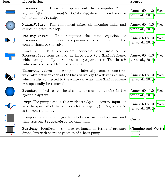Simplifications for hydronic system models in modelica
Abstract
Building systems and their heating, ventilation and air conditioning flow networks, are becoming increasingly complex. Some building energy simulation tools simulate these flow networks using pressure drop equations. These flow network models typically generate coupled algebraic nonlinear systems of equations, which become increasingly more difficult to solve as their sizes increase. This leads to longer computation times and can cause the solver to fail. These problems also arise when using the equation-based modelling language Modelica and Annex 60-based libraries. This may limit the applicability of the library to relatively small problems unless problems are restructured. This paper discusses two algebraic loop types and presents an approach that decouples algebraic loops into smaller parts, or removes them completely. The approach is applied to a case study model where an algebraic loop of 86 iteration variables is decoupled into smaller parts with a maximum of five iteration variables.
- Authors:
-
- Univ. of Leuven (Belgium); EnergyVille, Genk (Belgium)
- Lawrence Berkeley National Lab. (LBNL), Berkeley, CA (United States)
- Publication Date:
- Research Org.:
- Lawrence Berkeley National Lab. (LBNL), Berkeley, CA (United States)
- Sponsoring Org.:
- USDOE Office of Energy Efficiency and Renewable Energy (EERE), Energy Efficiency Office. Building Technologies Office
- OSTI Identifier:
- 1437004
- Grant/Contract Number:
- AC02-05CH11231
- Resource Type:
- Accepted Manuscript
- Journal Name:
- Journal of Building Performance Simulation
- Additional Journal Information:
- Journal Volume: none; Journal Issue: none; Journal ID: ISSN 1940-1493
- Publisher:
- Taylor & Francis
- Country of Publication:
- United States
- Language:
- English
- Subject:
- 42 ENGINEERING
Citation Formats
Jorissen, F., Wetter, M., and Helsen, L. Simplifications for hydronic system models in modelica. United States: N. p., 2018.
Web. doi:10.1080/19401493.2017.1421263.
Jorissen, F., Wetter, M., & Helsen, L. Simplifications for hydronic system models in modelica. United States. https://doi.org/10.1080/19401493.2017.1421263
Jorissen, F., Wetter, M., and Helsen, L. Fri .
"Simplifications for hydronic system models in modelica". United States. https://doi.org/10.1080/19401493.2017.1421263. https://www.osti.gov/servlets/purl/1437004.
@article{osti_1437004,
title = {Simplifications for hydronic system models in modelica},
author = {Jorissen, F. and Wetter, M. and Helsen, L.},
abstractNote = {Building systems and their heating, ventilation and air conditioning flow networks, are becoming increasingly complex. Some building energy simulation tools simulate these flow networks using pressure drop equations. These flow network models typically generate coupled algebraic nonlinear systems of equations, which become increasingly more difficult to solve as their sizes increase. This leads to longer computation times and can cause the solver to fail. These problems also arise when using the equation-based modelling language Modelica and Annex 60-based libraries. This may limit the applicability of the library to relatively small problems unless problems are restructured. This paper discusses two algebraic loop types and presents an approach that decouples algebraic loops into smaller parts, or removes them completely. The approach is applied to a case study model where an algebraic loop of 86 iteration variables is decoupled into smaller parts with a maximum of five iteration variables.},
doi = {10.1080/19401493.2017.1421263},
journal = {Journal of Building Performance Simulation},
number = none,
volume = none,
place = {United States},
year = {Fri Jan 12 00:00:00 EST 2018},
month = {Fri Jan 12 00:00:00 EST 2018}
}
Web of Science
Figures / Tables:
 Table 1: Illustration and short description of the main component models that are used in the example models.
Table 1: Illustration and short description of the main component models that are used in the example models.
Works referenced in this record:
Modelica BuildingSystems − eine Modellbibliothek zur Simulation komplexer energietechnischer Gebäudesysteme
journal, February 2013
- Nytsch-Geusen, Christoph; Huber, Jörg; Ljubijankic, Manuel
- Bauphysik, Vol. 35, Issue 1
Modelica Buildings library
journal, March 2013
- Wetter, Michael; Zuo, Wangda; Nouidui, Thierry S.
- Journal of Building Performance Simulation, Vol. 7, Issue 4
Depth-First Search and Linear Graph Algorithms
journal, June 1972
- Tarjan, Robert
- SIAM Journal on Computing, Vol. 1, Issue 2
Depth-first search and linear graph algorithms
conference, October 1971
- Tarjan, Robert
- 12th Annual Symposium on Switching and Automata Theory (swat 1971)
Works referencing / citing this record:
Model implementation and verification of the envelope, HVAC and controller of an office building in Modelica
journal, December 2018
- Jorissen, F.; Boydens, W.; Helsen, L.
- Journal of Building Performance Simulation, Vol. 12, Issue 4
Model implementation and verification of the envelope, HVAC and controller of an office building in Modelica
text, January 2018
- Jorissen, F.; Boydens, W.; Helsen, L.
- Taylor & Francis
Model implementation and verification of the envelope, HVAC and controller of an office building in Modelica
text, January 2018
- Jorissen, F.; Boydens, W.; Helsen, L.
- Taylor & Francis
Figures / Tables found in this record:

 Search WorldCat to find libraries that may hold this journal
Search WorldCat to find libraries that may hold this journal